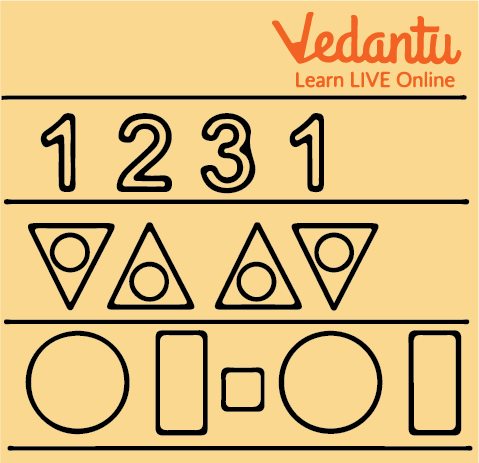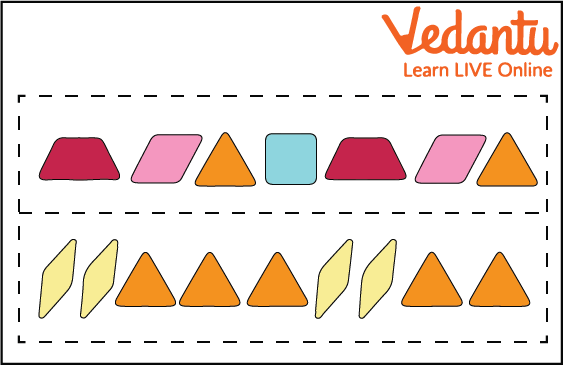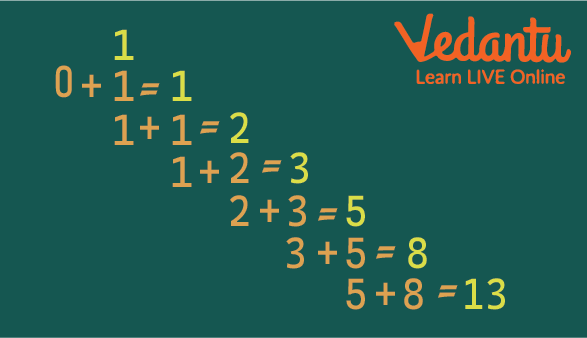




How to Spot and Create Patterns in Daily Life
A pattern is a series or chain that usually repeats itself. Colour, activity, form, number and other patterns that we see in our daily lives are examples of patterns. They might be finite or infinite and can be tied to any event or object. In Mathematics, a pattern is a sequence of integers that are connected to each other according to a specified rule. These rules specify how to compute or solve issues. In a sequence of 3, 6, 9, 12, _, each number increases by 3, therefore, the number after 12 is 15.
The pattern is a sequence that follows a specific order and a common relationship between each and every member. In Maths, there are several forms of patterns, such as numbers and symbols, picture patterns, logic patterns, word patterns and so on. The number pattern is the most widely employed since children are familiar with even numbers, odd numbers, skip counting and other concepts that aid in comprehending these patterns.

Example of Different Types of Patterns
Finite and Infinite Patterns
The pattern in which the first and last members of the pattern are known, the pattern is said to be a finite pattern.
Example of Patterns: In pattern 3, 6, 9, 12, and 15, the first term is 3 and the last term is 15.
An infinite pattern is a sequence in which the first member is known but the last member is unknown.
Example: In pattern 3, 6, 9, 12, 15, 18…, the first term is 3, but where the pattern will stop is not known.
Rules of Pattern
To create a specific pattern, you need to consider a specific set of rules. To apply these rules, you must first understand the nature of the sequence and the difference between two consecutive numbers given in the pattern. The following rule, which takes a little guesswork, works for the whole pattern.
Patterns can be formed using three categories.
Repeating Pattern - A type of pattern which follows the same rule in the whole pattern is known as a repeating pattern. Usually, these are letters and shapes.
Growing Pattern - When numbers are arranged in ascending order in a growth pattern, or when each number is greater than the previous number, such a pattern is called a growing pattern. Example: 2, 6, 10….
Shrinking Pattern - In this pattern, the numbers are sorted in descending order, or each number is less than the previous one. Example: 9, 8, 7, 6….

Repeating Pattern in Shapes
Types of Patterns in Maths
The Arithmetic Pattern - Usually referred to as the algebraic pattern is a number series formed by addition or subtraction to construct a number sequence connected to each other. If we are given two or more integers from the series, we may use addition or subtraction to identify the mathematical pattern and to find the missing number in a given sequence.
A Geometric Pattern - is a numerical sequence focused on multiplication and division. If we have two or more numbers in the sequence, we can easily discover the unknown numbers in the patterns by applying multiplication and division.
The Fibonacci Pattern - is a number sequence in which each number is produced by combining the two preceding numbers together. The number sequence begins with 0 and 1.

Fibonacci Pattern Example
Solved Examples
1. Find the missing term in the series 2, 8, 14, 20, __?
a. 24
b. 26
c. 30
d. 32
Ans: 26
Explanation: There is an addition of 6 in each number. By adding 6 to 20 you can find the missing term. Thus, the missing term will be 26.
2. 1, 2, 3, 4, 5………. this series is
a. Finite
b. Infinite
c. None of the above
Ans: Infinite
Explanation: Since there is only the first term known but the last term is unknown, so the series is an infinite series.
3. What is the next term of series 22, 20, 18, 16, _?
a. 14
b. 12
c. 15
d. 18
Ans: 14
Explanation: Since the series follows a decreasing order. Every term decreases by 2. So, the next term after 16 will be 14.
Conclusion
There are several forms of Maths patterns. They might be ascending or descending, multiples of a certain number, or a series of even or odd numbers. Seeing a pattern prompts us to think about and determine the rule that will allow the pattern to continue. Patterns can be made up of forms, objects and colours in addition to numbers.
FAQs on Patterns for Kids: Concepts, Examples & Practice
1. What are patterns in Maths for kids?
In Maths, a pattern is a sequence of things like numbers, shapes, or colours that are arranged following a specific rule. This rule repeats over and over again. For example, arranging toys as Car, Block, Car, Block... is a simple pattern because the 'Car, Block' sequence is repeated.
2. What are the main types of patterns that children learn in early classes?
As per the foundational NCERT syllabus, children primarily learn about a few fun types of patterns. These include:
- Shape Patterns: A repeating sequence of shapes, such as Circle, Square, Circle, Square...
- Number Patterns: A sequence of numbers following a rule, like 2, 4, 6, 8..., where 2 is added each time.
- Colour Patterns: An alternating sequence of colours, for instance, Red, Blue, Red, Blue...
- Letter Patterns: A sequence using letters of the alphabet, like A, B, C, A, B, C...
3. What is an example of a simple AB pattern for kids?
An AB pattern is a basic repeating pattern where two different items alternate one after the other. 'A' stands for the first item and 'B' for the second. A simple example is using fruits: Apple (A), Banana (B), Apple (A), Banana (B), and so on. The core repeating unit is 'Apple, Banana'.
4. What is a growing pattern?
A growing pattern is a pattern where the numbers or objects increase in a predictable way with each step. Unlike repeating patterns, something new is added each time. For example, a sequence of stars like *, **, ***, **** is a growing pattern because one star is added at every step.
5. What are some examples of patterns we can see in nature?
Nature is filled with amazing patterns that are great examples for kids. Some common ones include:
- The stripes on a zebra or a tiger.
- The symmetrical and colourful wings of a butterfly.
- The repeating arrangement of petals on a flower.
- The spiral shape of a snail's shell.
6. Why is it important for kids to learn about patterns?
Learning about patterns is a fundamental maths skill for several reasons. It helps children develop logical thinking by teaching them to make predictions and understand what comes next. Recognising patterns is a key step towards understanding more complex mathematical concepts like multiplication, skip counting, and algebra later in their education.
7. How can you explain a repeating pattern to a child using everyday objects?
To explain a repeating pattern, you can use familiar objects to make it interactive. For example, take a spoon and a fork. Arrange them on a table as Spoon, Fork, Spoon, Fork... Then, ask the child, "What do you think comes next?" This hands-on activity helps them physically see and understand the repeating rule in a simple and memorable way.
8. What is the main difference between a growing pattern and a repeating pattern?
The key difference lies in how they change. A repeating pattern has a fixed unit that is copied over and over again (e.g., Triangle-Square, Triangle-Square). The pattern does not get bigger. In contrast, a growing pattern increases with each step according to a rule (e.g., 1 block, 2 blocks, 3 blocks). It gets bigger or longer over time.
9. Besides shapes and numbers, can patterns be made with sounds or movements?
Yes, absolutely! Patterns can be multisensory. A sound pattern can be created by clapping and snapping in a sequence, like 'Clap, Snap, Snap, Clap, Snap, Snap...'. Similarly, a movement pattern can be made by performing actions in order, such as 'Jump, Turn, Jump, Turn...'. These are excellent ways to teach the concept of a repeating rule beyond just drawing or writing.























